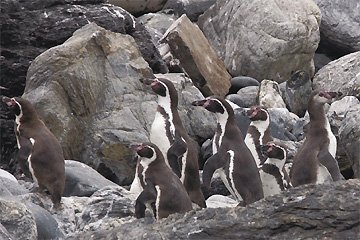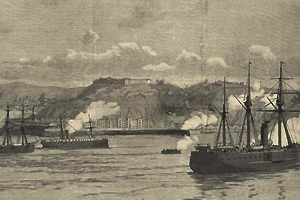The Region of Coquimbo is located between the 29° 02´and the 32° 16 south latitude and from the 69° 49´longitude up to the Pacific Ocean, limiting northwards with the Region of Antofagasta, southwards with the region of Valparaiso , eastwards with Argentina and westwards with the Pacific ocean.
Its regional capital is the city of La Serena and is divided administratively in 15 communes and three provinces, separating it transversally. Its total surface reaches the 40.579,9 km2, which represents the 5, 37% of the continental and islander Chile.
According to the 2002 Census, the regional population reaches 603.210 inhabitants, out of which 306.053 are women and 297.157 are men, being then the first the 51% of the total population.
The population growth rhythm goes beyond the country’s and converts it in one the most dynamic regions, since in both censuses this figure reached an annual average rate of 1, 8 persons for each 100 inhabitants, very superior to the 1, 2 average of the country.
On the other hand, 78, 1% (470.922 persons) is an urban population, while only the 21, 9% (132.288) lives in rural sectors. Among the most populated communities are Coquimbo, La Serena and Ovalle.
There are three clearly detectable zones in which are located the main human settlements. In the coast are the two most important cities of the region, Coquimbo and La Serena, which nearness and growth has formed a conurbation. Both cities bases their economy mainly in activities oriented to trade and tourism.
More interior wards and valleys lengthwise, we can find villages dedicated to agricultural tasks; among them are Vicuña, Ovalle and Illapel. In the Andean foothill and in the Andes Ranges are located villages such as La Higuera, Salamanca and Andacollo, whose inhabitants also develop activities related with the small and the industrial mining.
Administrative organization
The Region of Coquimbo has three provinces.
These are:
Province of Elqui: its surface reaches a 16.895,1 km2 with 365.371 inhabitants, out of which 325.655 lives in urban zones and only 39.806 in rural sectors. Is composed by the following communities:
-
La Serena: with a surface of 1.892,8 km2 and a population reaching 160.148 inhabitants, out of which, 147.815 lives in urban areas and 12.333 in rural areas.
-
Coquimbo: its surface is of 1.429,3 km2. It has a population of 163.036 persons out of which 154.316 inhabits an urban area and 8.720 in a rural area.
-
Andacollo: it embraces a 310,3km2, inhabiting a total of 10.288 persons, 9.444 are located in an urban area and only 844 in a rural zone.
-
La Higuera: its surface reaches a 4.158,2 km2 and a population of 3.721 inhabitants (1.637 is women and 2.084 are men).
-
Paihuano: with a surface of 1.494,7 km2 and 4.168 inhabitants. All of them in rural zones.
-
Vicuña: comprising a surface of 7.609,8 km2, while its population reaches 24.010 persons, out of which, 12.910 lives in an urban area and 11.100 in the rural area.
Province of Limari: its total surface reaches 13.553,2 km2 with 156.158 inhabitants. Is composed by the following communes:
-
Ovalle: with a surface reaching 3.834,5 km2 and has 98.089 inhabitants (50.284 women and 47.805 men), out of which 73.790 has settled in urban areas.
-
Rio Hurtado: it has a surface of 2.117,2 km2 and a population of 4.7771 persons (2.326 women and 2.445 men), all of them living in rural zones.
-
Monte Patria: its surface reaches 4.366,3 km2 and the population rises to 30.276 inhabitants (14.925 women and 15.351 men). Most of them in rural zones.
-
Combarbala: it has a surface of 1.895,9 km2 and a population of 13.-4883 inhabitants (6.7788 women and 6.695 men). Most of them, 7.989 persons live in rural sectors.
-
Punitaqui: with a surface of 1.339,3 km2 and a total of 9.539 inhabitants (4.791 men and 4.748 women, out of which 5.924 are in rural zones.
Province of Choapa: with a surface reaching 10.131,6 km2, while its population is of 81.681 persons. Is formed by the following communities:
-
Illapel: it has a surface of 2.629, 1 km2, with a population reaching 30.355 inhabitants. Out of the total, 21.826 persons live in an urban area and 8.529 in a rural area.
-
Canela: with a surface of 2.196,6 km2 and a total population of 9.379 persons (4.737 men and 4.642 women), out of which 7.635 has settled in rural sectors.
-
Salamanca: it comprises 3.445,3 km2 with a population of 24.494 inhabitants (11. 451 women and 13.043 men). 12.689 are in urban zones and 11.805 are in rural areas.
-
Los Vilos: it has a surface of 1.805 km2 and a population of 17.453 inhabitants (8.595 women and 8.858 men).
Relief
It is possible to distinguish four forms characterizing this territory, despite the particular disposition of the relief::
– Coastal plains: modified by the marine action, in this zone of the country the coastal plains are like several scaled terraces of great dimensions; only in La Serena appears as a fringe of almost 40 km length.
– Coastal Ranges: it looses continuity and is interrupted by the small Andean mountain ranges that unpin forming the transversal valleys. In it are located the Talinay heights and the Parque Nacional Fray Jorge (further on, its peculiar characteristic shall be analyzed).
–Intermediate depression: appears discontinue and interrupted by hills and valleys which can be clearly appreciated inland the Elqui and Limari valleys.
– The Andes Mountains: in this section of the country, it is featured for being high, massif and for lacking volcanic activity.
From it unpins two important mountain ranges, called Doña Rosa and Doña Ana; emerging also several highlands.
The heights, that in the septentrional part reach the 4.500 masl, are diminishing as they advance southwards.
The most important summits are the Las Tortolas (6.320 masl), the Olivares (6.250 masl), the Volcan (5.568 masl), Incahuasi (4.767 masl), the Patos or the Guana (4.855 masl) and the Bayo (4.330 masl) mountains.
Hidrography
We can find three important hydrographic basins born at the Andes Ranges, directing their flow according to the location of transversal valleys and flowing into the Pacific Ocean.
They belong to the Elqui, Limari and Choapa Rivers giving their names to the provinces of the region.
The Elqui River is born in the Andes Ranges as a product of the confluence of the Claro and Turbio rivers; draining a basin of 9.700 km2 and its length reaches 170 kilometers.
Their feeding regimes is mixed, during winter is nurtured by rainfalls and in summer by the snow thawing, and its resources are used, mainly, in its valley’s crops irrigation, as well as for human consumption. It flows into the ocean near La Serena.
The Limari River has the largest surface of a hydrographic basin reaching 11.972 km2. Is born from the union of the Hurtado and Grande rivers and is nurtured mainly by the snow thawing; it has a water regulating system, due to the Recoleta, Cogotí and La Paloma dams. Its estuary is located southwards the Parque Nacional Fray Jorge.
The Choapa river is born in the Andes Ranges and ends in the Huentelauquen inlet. It has the region’s lowest length basin, with a surface of 8.239 km2. Its main affluent is the Illapel river which joins its flow in the Choapas´ middle course.
Other tributaries are the Chalinga river and the Camisas, La canela and Millahue estuaries..
Water regulators
Dams are structures built for storing and controlling the water of a river and, also, are used to take advantage of them in an effective and profitable fashion.
Due to the fact in this region there are still no abundant precipitations, most of the water flows have dams, allowing the development of agriculture and ensuring the water provision for human consumption.
Among the main ones we can point out:
– Laguna: is located in the Turbio river basin (at the frontier with Argentina regulating the Elqui river flow and begin to operate in 1999.
– Recoleta: controls the Hurtado river flow Limari river affluent) covering a surface of 555 hectares. Is dated from the 30 decade and has a capacity of 97 millions cubic meters.
– Puclaro: is located at 50 km from La Serena, westwards Vicuña, in the Elqui river flow. It was built between 1996 and 2000, with a capacity for 2300 millions cubic meters of water ensuring the irrigation for the agricultural crops in the Elqui valley.
– La Paloma: in the Limarí valley, at the confluence of the Grande and Huatulame rivers. Is the largest Chilean dam with irrigation functions.
– Culimo: is located in the middle flow of the Quilimarí river controlling the amount of water used in the irrigation of the valley with the same name.
– Cogotí: it was built at the confluence of the Pama and Cogotí rivers, in the years 1934 and 1939. It stretches on a surface of 850 hectares and with a capacity of 150 million cubic meters, supplying mainly the Limarí valley.
Climate
The Region of Coquimbo is a climatically transitional zone, among the arid conditions of the desert and abundant moisture and vegetation given farther south.
Thus, during winter there are rainfalls that, even though scarce, allow the development of new vegetable associations and the existence of a very important agriculture for the region’s economy.
Three important climatic variations can be point out, but with particular characteristics: desert, steppe and the high mountain tundra.
– Coastal desert with abundant clouds: in the fringe besides the coast, the Pacific ocean moderating action produces even temperatures with an average between the 10°C up to the 20°C.
One of its main features is the abundant moisture that generates a fogginess known as camanchaca. This is larger in sectors were the coastal steep rock face reaches considerable heights, as in the Talinay heights and in the Parque Nacional Fray Jorge.
– Transitional desert: westwards the coastal fringe it predominates and has variable and exiguous rainfalls, besides having larger thermal variations than in the coast; the diminishing of cloudiness allows a grater sky clearance.
– Abundantly cloudy steppe: it stretches from the Quebrada Honda up to Quilimarí and among its main characteristic features we can point out that its rainfalls vary southbound, from 100 mm to 275 mm. Also, it registers average temperatures oscillating between the 5°C. and 15°C (minimum and maximum) and has a considerable morning and nightly cloudiness.
– Marginal template steppe: this predominates in the valleys of the Elqui, Limari and Choapa regions, with oscillating temperatures between the 14 and 16°C, while precipitations reach from the 100 up to 250 mm, mainly concentrating in August.
– Cold mountain steppe: this climatic variety develops between the 1.650 and 4.000 masl and outstands for its atmospheric transparence enabling astronomic observation. In this zone the temperature varies from 8°C and 10°C.
Biogeography
The soils of this country’s zone have relatively better conditions for the development of different vegetable species, since there is a notorious increase of rainfall compared with previous regions.
Besides, there are other factors influencing the distribution of different vegetable associations increasing the abundance southbound and sea bound. Among them we have: the disposition of valleys, the coastal cloudiness and the chain of small transversal mountain ranges.
At the littoral fringe outstands the coastal scrub, which is formed by succulent plants, evergreen bushes and cactuses such as the Pillar cactus (Equinopsis chilensis), Wild cactus ( Eulychinia acida) and the Sandillón de los ratones(Eriosyce rodentiophila). Also, is possible to appreciate bushes such as the Bone breaker bush (Ephedra andina).
In this region’s inland sector and mainly in its northern boundary, still are the flowery desert phenomena, where the seeds stay in a latent state until the arrival of the rainfalls.
Also, in this sector begins to develop formations of steppes with bushes, one of the basic characteristics is that they use different and far spaces among them, forming a less united vegetation.
It is possible to esteem, in this region, species such as the Peruvian shrub (Fabiana imbricate) the Andean violet (Viola andina) and the Biobio (Gymnophiton robustum). Farther south, grows other such as the Frangel (Kageneckia angustifolia), the Cadillos or trunes (Acaena pinnatífida a A. splendens), el Guindillo (Valenzuela trinervis), the Coliguay (Colliguaja integerrima), the Lun (Escallonia myrtoidea) and the Romerillo (Baccharis linearis).
If we ascend, is easy to detect at a greater height the diminishing of vegetation, dominating species xerophytes (growing in dry environments), with grass such as the Coirón amargo (Stypa chrystopylla).
Meanwhile, the fauna of the Andean zone outstands for mammals such as the Elegant Fat-Tailed Mouse (Thylamys elegans), the Long-Tailed Chinchilla (Chinchilla lanigera), the Argentinean Grey Fox and the Patagonian Fox (Pseudalopex griseus and P. culpaeus) and the Cougar (Puma concolor).
The bird fauna is composed by species such as the Picui Ground-Dove (Columbia picul) and the Dark-faced Ground -Tyrant (Muscisaxicola macloviana).
From the Limarí river and stretching southwards this region, mostly in the bottom of valleys and creeks, a spiny thicket begins to develop.
This is a thin bush (which species are spatially separated), in which the spiny thicket is associated with esclerophil bushes such as the Toxicodendron (Lithrea caustica), the Molle (Schinus latifolius) and the Soap Bark Tree (Quillaja saponaria), among others.
Wild protected areas
– Parque Nacional Fray Jorge: is located at 150 km from La Serena, in the community of Ovalle between the 30°38´and 30°44´ south latitude and the 71° 35´to the 71° 35´west longitude. It was created in 1941 and has 9.959 hectares; its main objective is to preserve the integrity of the species there living.
It has the particularity of having a typical Valdivia vegetation in a zone where predominates the coastal desert characteristics, with rainfalls reaching only the 113 mm annual. This is explained by the existence of the camanchaca and that the under story receives sufficient water to live as dew /equivalent to 1.000 mm annual rain).
Thus, abundant species such as the Winter’s Bark (Drimys winteri), the Aextoxicon (Aextoxicon punctatum), the Tepa (Laureliopsis philipiana) and a great amount of ferns.
The park was named Reserva Mundial of the Biosfera for its ecological relevance.
– Reserva Nacional Pinguino de Humborldt: is located just in the boundary separating both Atacama and Coquimbio regions. It includes three islands, Damas, Choros and Chañaral de Aceituno, which comprises in its total extension a surface of 859,3 hectares.
It was created in 1990 and lives in it species such as the Humboldt Penguin (Spheniscus humboldtii), the Bottle-nosed Dolphin (Tursiops truncates), the Sea-Lion (Otaria byronia), the Magellan sea otter (Lutra feline) and the Peruvian diving petrel (Pelecanoides garnotti), etc.
– Reserva Nacional Las Chinchillas: located at 56 km northwards Illapel ( Choapa province) with 4.229 hectares. Created in 1983, has as main objective to preserve the small population of Chinchillas that are under conservation problems.
– Monumento Natural Pichasca: assembled at 56 km northwards Ovalle, in the commune of Rio Hurtado. This place, of 128 hectares, was named Natural Monument in 1982 and has numerous prehistoric fossil remains of vegetable species as well as of animals.
Some fossil trunks of more than 70 million years and dinosaur bones of the species Antartocosaurus are most outstanding. Also, there are traces of Incasic settlements and some rocky paintings evidencing man’s presence for almost 9.000 years ago.
Latent threats
The main environmental problems that the Region of Coquimbo must face are:
-
Desertification and loss of the forest cover due to, mainly, mining activities, the development of ovine cattle breeding and the preparation of new cultivating soils.
-
Fishing over-exploitation, this has derived in the implementation of capture limiting quotas, for the crafty as well as for the industrial fishing.
-
Biodiversity destruction.
-
Coastal sea shore alteration, as a product of the development of real estate projects.
-
The zone’s soil and water courses contamination increase.








 En 1866 Valparaíso fue bombardeado
En 1866 Valparaíso fue bombardeado